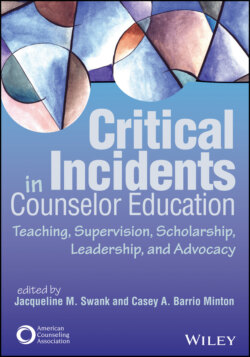Читать книгу Critical Incidents in Counselor Education - Группа авторов - Страница 57
Critical Incident Response
ОглавлениеKathryn L. Henderson
Unanticipated issues are bound to pop up when creating assignments as detailed and involved as SL projects. The author identified several critical issues related to ethical principles and standards and critically examined how the roles and actions of the SL supervisor and instructor either supported or hindered Beth.
Examining the scenario through the lens of the ACA Code of Ethics (ACA, 2014) is critical for ethical practice. The author identified Beth’s boundaries of competence as a student who is not yet an intern, potential harm to her SL clients, and her lack of cultural competence and awareness. He also highlighted the ethical principle of veracity, which has important implications for Beth’s decision-making process. Beth’s lack of disclosure to Ms. Mitchell regarding her decision to hold individual sessions with Quetzal is dishonesty by omission. Failure to truthfully initiate contact with supervisors can impact trust and lead to a rupture in the relationship. Not only did Beth ignore the rules of the SL site, but she did not appear to realize that her independent decision-making and subsequent action were inappropriate or outside the boundaries of her competence. These factors speak to the ethical principle of fidelity; Beth’s actions could lead to Ms. Mitchell not trusting her. This scenario could result in dismissal from the SL site.
The site supervisor’s absence created a space for this ethical dilemma to occur. The author provided a thorough analysis of Ms. Mitchell’s lack of adequate supervision during her absences. This circumstance has implications for the instructor’s role in planning for supervisors’ absences. As he might for an internship, Professor Edwards could have developed clear, preventive parameters for site supervisor absences that applied to all students.
Given the ethical violations that occurred, Professor Edwards might also consider formal remediation for Beth. Professor Edwards did ask Beth to reflect on her actions through the lens of the ACA Code of Ethics (ACA, 2014), which can be regarded as summative evaluation and informal remediation. However, additional options are available. The student’s performance at the site was not included in the evaluation of the assignment. One way to address how students’ behaviors impact their performance is through gatekeeping and remediation. The ACA Code of Ethics instructs counselor educators to remediate students when necessary (ACA, 2014, p. 15). One way to determine whether students’ behavior warrants remediation is by consulting with faculty; consultation with peers is best practice as well as ethical practice (ACA, 2014). Questions for Professor Edwards to consider during consultation include the following: Is Beth demonstrating similar or new problems in other courses? If Beth repeats these behaviors, would there be different outcomes or consequences? If Beth behaved in a similar way during her clinical internship, what would be the consequences?
The author identified many ways in which Professor Edwards could better prepare students for the SL assignment. In addition, he could have clarified at the beginning that students would not be engaging in counseling, which is outside the boundaries of their competence. This clarification is often made in skills-based courses prior to practicum to reinforce that students are practicing skills and not offering counseling. Professor Edwards could also have provided an overview of ethical principles and standards pertinent to the SL experience. Beth was concurrently learning ethics in a different course, but she may not have been exposed to ethical standards relevant to SL sites. Professor Edwards should consult with his colleagues prior to the start of the SL assignment about what content on ethics has already been covered. Any content on ethics not yet taught should be included in Professor Edwards’s course prior to the beginning the SL project.
The very enriching nature of SL demands complex considerations of instructors and students unique to these assignments. Beth’s dilemma highlights the unique opportunities and challenges inherent in SL. The aftermath of such dilemmas provides space for fundamental growth and learning for faculty and students.
• • •
